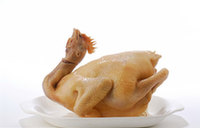A seasonal preoccupation
 |
|
Pomp and ceremony at the first crab harvest at Fairmont Hotel Yangcheng Lake, where the hotel and its sister property, Yufeng Organic Farm, raise hairy crabs. Photos Provided To China Daily From Fairmont Hotel Yangcheng Lake. |
Local farmers and fishermen ate them before they became such a national obsession, but without much enthusiasm.
|
|
"There were better things such as our famous mandarin fish and the little yellow croakers. We didn't need to eat the crabs," she recalls.
She still cannot believe that people will pay so much money for hairy crabs.
From days of yore, the crabs of Yangcheng Lake appealed only to those with time, like poets and scholars, and the very rich.
The crabs were valued mostly for a single mouthful of fragrant roe, because they really had very little meat compared to the more robust mud crabs from the sea.
Hairy crabs were seasonal food to be enjoyed with osmanthus wine when the harvest moon was high and when gardens were scented with chrysanthemums.
Their modern renaissance began in the 1980s, after leader Deng Xiaoping's historical push for China to transit from a planned to an open economy.
Hong Kong, well-known as a gourmet hub in the forefront of food trends, started paying big bucks for genuine Yangcheng Lake hairy crabs, a fad started by the growing number of mainland Chinese officials and businessmen from the Jiangsu-Zhejiang area who were based in the then-British colony.
Perhaps they were homesick for a taste of home.
Other Southeast Asian cities with large ethnic Chinese populations such as Bangkok and Singapore soon followed, with supply mainly channeled through the international hotel chains.
In the years that followed, the trend came back full circle, fueling demand in the place of origin.


















